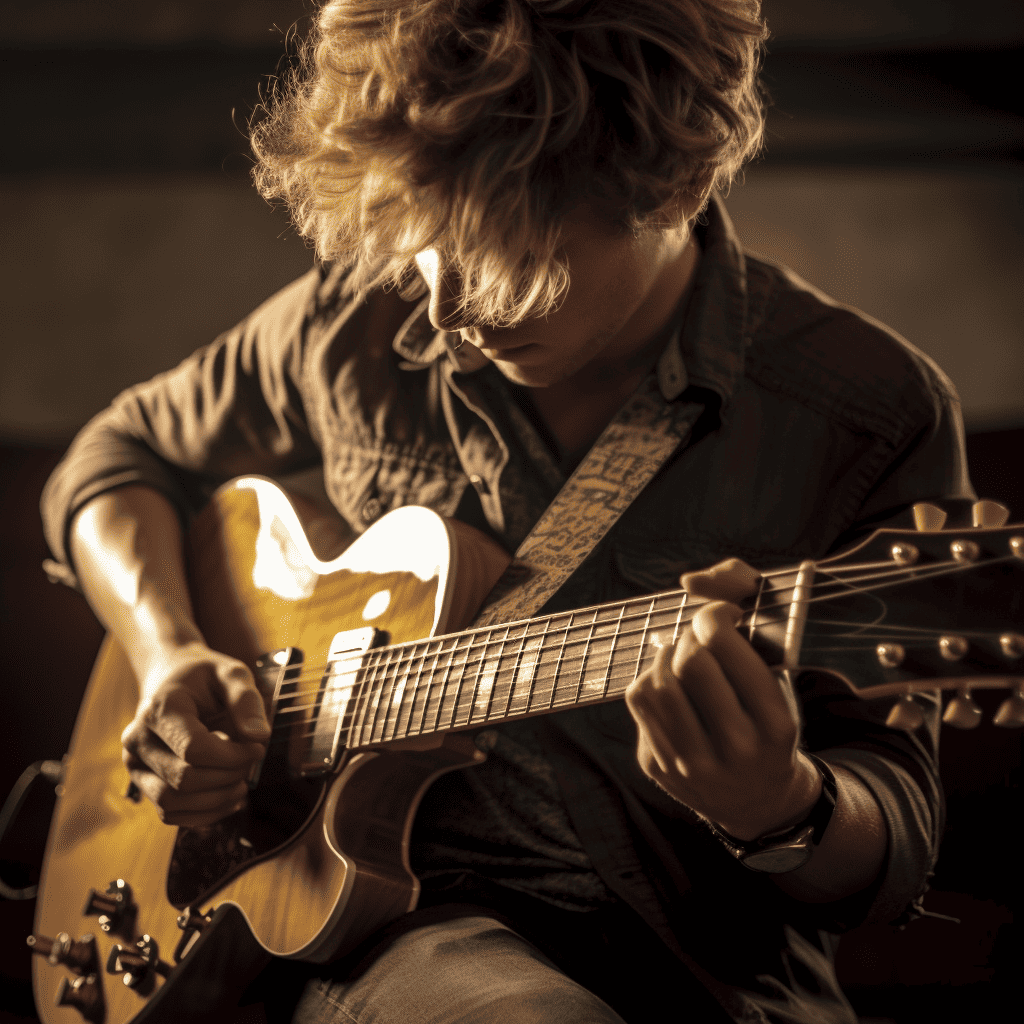I’ve spent countless hours strumming chords, picking melodies, and exploring the world of guitar playing. But sometimes, I’ve found myself wondering, why does my wrist hurt when playing guitar? It’s a question that plagues many guitarists, both new and experienced. In this post, we’ll explore the causes and remedies for wrist pain, as well as dive into why playing guitar might also bother your fingers.
Understanding the Pain: Why Does It Happen?
Improper Technique and Posture
Holding the Neck Incorrectly: When gripping the neck of the guitar, a seemingly slight misalignment in the wrist might lead to discomfort. I’ve experienced this pain firsthand when I held the neck either too tightly or at an awkward angle. A slight adjustment can make all the difference.
Thumb Positioning: I’ve noticed that where I place my thumb on the neck has a considerable impact on wrist alignment. Keeping the thumb in a neutral position, rather than hooked over the top of the neck, often helps in maintaining proper wrist posture.
Body and Guitar Alignment: The way I align my body and the guitar also plays a significant role in wrist pain. Sitting with a straight back and keeping the guitar at the right angle can promote a healthy wrist position. I’ve used footstools and ergonomic chairs to find a comfortable playing position. You kill two birds with one stone on this tip, proper back posture is of course also great for your back (take it from the guy with multiple slipped discs).
Overuse and Strain

Playing for Long Periods: There’s a point in every guitarist’s journey where passion takes over, and you just can’t put the guitar down. I know I’ve been there! But playing for hours on end without proper breaks can cause strain, leading to wrist pain.
Importance of Rest and Warm-up: I learned the hard way that rest and warm-up are essential. Just as athletes stretch before a game, taking time to flex and stretch the wrist and fingers can prepare them for the physical demands of playing. Likewise, allowing adequate rest between practice sessions gives the muscles time to recover.
Underlying Medical Conditions
Carpal Tunnel Syndrome: Sometimes, the cause might be more complex. Conditions like carpal tunnel syndrome can manifest as wrist pain during guitar playing. In these cases, I’ve found that simple adjustments might not be enough, and medical consultation becomes necessary.
Arthritis or Tendinitis: Other underlying health conditions, such as arthritis or tendinitis, might also contribute to wrist pain. Understanding the root cause of the pain may very well require a visit to the doctor if your issue is significant enough.
Understanding and addressing the causes of wrist pain in guitar playing can make a significant difference in your musical journey. As I have discovered, paying attention to the little details in posture and technique, recognizing the importance of rest, and being aware of underlying health conditions can lead to a more enjoyable and pain-free playing experience. The connection between musician and instrument is a delicate balance, and maintaining that harmony is key to expressing oneself fully through music.
Finger Pain in Guitar Playing

Playing the guitar is an enriching and enjoyable experience, but it can sometimes lead to discomfort or even pain in the fingers. This is a concern that many musicians face at various stages of their playing journey, whether they are just starting out or have been playing for years. Addressing finger pain specifically, I’ve seen it manifest in various forms. Here’s how I’ve tackled each one:
Finger Fatigue
This is common among beginners, and even I felt it when I first started. Building finger strength through consistent practice and exercises alleviates this fatigue.
Blisters and Calluses
I remember the blisters from my early days of playing. Though uncomfortable, they eventually turned into calluses, providing a natural cushion.
Finger Joint Pain
This might indicate a more serious issue. If you experience joint pain, consulting a medical professional, as I did, can diagnose and treat the underlying cause.
Pressing on the Strings
Finding the Right Pressure
When I first started learning guitar, I remember pressing the strings so hard, believing that’s what I had to do. It took some time to realize that pressing too hard could lead to finger pain. By experimenting and finding the right amount of pressure needed to fret a note, I was able to reduce unnecessary strain on my fingers.
Importance of Finger Placement
Where you press the string also matters. Pressing just behind the fret, instead of in the middle between frets, can make it easier to play a note without needing excessive force. This insight has allowed me to play with greater ease and less fatigue.
The Need for Warm-Up
I’ve found that jumping straight into a practice session with cold hands can cause discomfort in the fingers. Your muscles and joints need some time to warm up. Simple exercises, like shaking the hands or flexing the fingers, can be beneficial. I often spend a few minutes on warm-up exercises, and it has made my practice sessions much more comfortable.
Room Temperature Considerations
I also realized the importance of practicing in a room with a comfortable temperature. Cold environments can lead to stiffer muscles, so ensuring the room is warm enough has helped me play without pain.
Using the Wrong Guitar or Strings
Choosing the Right Guitar Neck

Sometimes, it’s not about you, it’s about the instrument. Using a guitar with a neck too wide or too slim can create tension in the fingers and wrist. Finding a guitar that fits my hand size and shape has made a significant difference in playing comfort.
Selecting Suitable Strings
Similarly, using strings that are too thick or too thin can lead to difficulties. Thicker strings might require more pressure, while thinner strings might not provide enough resistance. Experimenting with different string gauges helped me find the perfect balance for my playing style.
How to Prevent Wrist and Finger Pain
Adjust Your Playing Position
I’ve learned that the angle of the wrist while holding the guitar neck plays a crucial role in comfort. Experiment with different positions and find what feels most natural.
Mind the Thumb Placement
Where you place your thumb on the neck can affect your wrist’s alignment. I’ve found that keeping the thumb roughly parallel to the frets helps in maintaining a comfortable posture.
Stretch and Warm Up
Just as you wouldn’t run a marathon without stretching first, you shouldn’t dive into a guitar session without warming up. Simple hand and wrist stretches can make a difference.
Take Regular Breaks
I’ve found that pacing myself, taking short breaks, and listening to my body prevents strain and discomfort.
Consider Your Gear
Choose the Right Guitar and Strings: Every guitarist has unique preferences and physical characteristics. Selecting a guitar and strings that fit your hands can alleviate unnecessary strain.
Consult a Music Teacher: I’ve benefited immensely from professional guidance. A seasoned guitar teacher can observe your playing and suggest personalized adjustments to your technique.
Seek Medical Advice: Persistent pain might indicate an underlying medical condition. If home remedies don’t alleviate the pain, seeking medical advice is prudent.
Consider Alternative Playing Techniques
Using a Slide

I’ve seen some guitarists, myself included, use a slide to play the guitar, especially when dealing with wrist or finger discomfort. This technique not only adds a unique sound to the music but also alleviates the pressure on the fingers.
Slides can be made of glass, metal, or ceramic, each providing a different tone and feel. Selecting the right slide that fits your finger comfortably and aligns with your preferred musical style is crucial. I’ve experimented with different materials and found that each one can bring something special to the music.
Playing with a slide requires practice, especially in controlling the pressure and position over the strings. I’ve spent time with tutorials and practice exercises to master the touch, ensuring I can glide smoothly without pressing too hard.
Fingerstyle vs. Pick
Switching between fingerstyle and using a pick can change the dynamics of strain on the wrist and fingers. Fingerstyle allows for a more nuanced control over individual strings. It can feel more natural and less straining to some players. I’ve noticed that playing fingerstyle opens up a world of textures and dynamics in the music.
Using a pick, on the other hand, offers a different experience. It can provide a crisper, more defined sound and often allows for quicker string attacks. Some players may find it easier to play for extended periods with a pick without discomfort.
Balancing Both Techniques
I found that varying my playing style keeps things fresh and reduces repetitive strain. By consciously switching between fingerstyle and pick playing, I’ve been able to adapt to different musical contexts while also taking care of my hands.
Experimentation is Key
Trying new approaches and being open to various techniques has been an enriching part of my musical journey. Exploring fingerpicks, thumb picks, or hybrid picking techniques offers even more options. Each technique has its advantages and can contribute to personal comfort and creative expression.
The Importance of Equipment
Ergonomic Guitars: Investing in an ergonomic guitar, designed with the natural curvature of the hand and wrist in mind, can make a tremendous difference. I’ve tried a few and noticed significant improvements in comfort.
Adjustable Guitar Straps: Your guitar’s height and angle can influence your wrist position. I found that using an adjustable strap to place the guitar at a comfortable height reduced stress on my wrist.
Mindfulness and Body Awareness: I’ve learned that being mindful of my body while playing is one of the best ways to prevent discomfort. Paying attention to the signs, like tingling or stiffness, and reacting promptly can ward off more serious issues.
Exercises and Physical Therapy: If pain persists, physical therapy and targeted exercises can be beneficial. I’ve worked with professionals who provided exercises that specifically strengthened my wrist and fingers, improving my endurance and reducing pain.
Alternative Guitar Playing for the Injured Musician
Injuries happen, but that doesn’t mean the music has to stop. If you’re injured, you can consider trying out alternative tunings to reduce the amount of stretch and pressure required to play certain chords. This can be especially helpful if you’re dealing with a sprain or strain.
Conclusion
In conclusion, wrist pain while playing the guitar is a common issue that often stems from improper technique, overuse, or underlying health conditions. Addressing this discomfort requires a careful examination of your playing habits, posture, and guitar setup. Implementing proper techniques, taking regular breaks, and seeking professional guidance when needed can alleviate pain and prevent future problems. It’s vital to remember that listening to your body and being mindful of your approach to playing can make your musical journey not only more enjoyable but also sustainable and pain-free. Whether you’re a beginner or a seasoned player, taking these simple but essential steps can help ensure that your passion for playing guitar doesn’t become a painful burden.
Frequently Asked Questions
Q: Why does my wrist hurt when playing guitar?
A: Wrist pain when playing guitar can result from improper technique, overuse, or underlying medical conditions.
Q: Can playing guitar cause carpal tunnel syndrome?
A: While playing guitar itself is unlikely to cause carpal tunnel syndrome, improper technique and excessive strain might exacerbate existing conditions.
Q: How can I strengthen my fingers for guitar playing?
A: Finger exercises, proper technique, and consistent practice can build strength in your fingers, enhancing your playing and reducing fatigue.
Q: What should I do if my fingers bleed while playing guitar?
A: If your fingers bleed, it’s essential to stop playing and allow them to heal. If the problem persists, seeking medical advice is wise.
Q: Is it normal to feel pain when learning to play the guitar?
A: Some discomfort, especially in the fingertips, is normal when learning to play the guitar. However, persistent or sharp pain should be addressed through proper technique or medical consultation.
